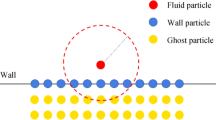Abstract
The objective of this study was to develop a numerical analysis method based on the moving particle semi-implicit method for simulating shipping water on a moving ship. Towing tests of a very large crude carrier were numerically analyzed for three typical wavelengths. The ship was forced to move in order to express previously measured ship oscillations, and the calculated fluid behavior and the impact pressure on the deck were compared with the experimental results.













Similar content being viewed by others
Abbreviations
- B :
-
Breadth
- c :
-
Phase velocity
- D :
-
Depth
- d :
-
Draft
- f :
-
Wave frequency
- F :
-
Freeboard
- g :
-
Acceleration of gravity
- h :
-
Water depth
- k :
-
Wave number
- \( \vec{K} \) :
-
External force
- l 0 :
-
Spacing between adjacent particles in the initial configuration
- L pp :
-
Ship length between perpendiculars
- N :
-
Total number of particles
- n i :
-
Particle number density of ith particle
- n 0 :
-
Constant of the particle number density
- P :
-
Pressure
- \( \vec{r} \) :
-
Position vector of particle
- r :
-
Distance between particles
- r e :
-
Radius of the interaction domain
- t :
-
Time
- T e :
-
Wave encounter period
- \( \vec{u} \) :
-
Flow velocity
- u :
-
Velocity component in the X-direction
- v :
-
Velocity component in the Z-direction
- w :
-
Weight function
- Z :
-
Number of space dimensions
- β :
-
Parameter for the free surface
- Φ:
-
Velocity potential
- ϕ :
-
Arbitrary quantity
- η :
-
Wave profile
- λ :
-
Parameter for Laplacian model and the wavelength
- μ :
-
Viscosity
- υ :
-
Kinematic viscosity
- ρ :
-
Density
- ω :
-
Angular frequency
- ζa :
-
Wave amplitude
- ζw :
-
Wave height
References
Tasaki R (1961) On shipping water (in Japanese). Monthly report of transportation technical research institute 11(8):357–388
Goda K, Miyamoto T (1976) A study of shipping water pressure on deck by two-dimensional ship model tests (in Japanese). J Soc Nav Archit Jpn 140:16–22
Mizoguchi S (1988) Analysis of shipping water with experiments and numerical calculations (in Japanese). J Soc Nav Archit Jpn 163:150–159
Ogawa Y, Taguchi H, Ishida S (1997) Experimental study on shipping water volume and its load on deck (in Japanese). J Soc Nav Archit Jpn 182:177–185
Greco M, Landrini M, Faltinsen OM (2004) Impact flows and loads on ship-deck structures. J Fluids Struct 19:251–275
Yamasaki J, Miyata H, Kanai A (2005) Finite-difference simulation of green water impact on fixed and moving bodies. J Mar Sci Technol 10:1–10
Nielsen KB, Mayer S (2004) Numerical prediction of green water incidents. Ocean Eng 31:363–399
Hirt CW, Nichols BD (1981) Volume of fluid (VOF) method for the dynamics of free boundaries. J Comput Phys 39:201–225
Hu C, Kashiwagi M (2004) A CIP-based method for numerical simulations of violent free-surface flows. J Mar Sci Technol 9:143–157
Yabe T, Xiao F, Utsumi T (2001) The constrained interpolation profile method for multiphase analysis. J Comput Phys 169:556–593
Gómez-Gesteira M, Cerqueiro D, Crespo C et al (2005) Green water overtopping analyzed with a SPH model. Ocean Eng 32:223–238
Shibata K, Koshizuka S (2007) Numerical analysis of shipping water impact on a deck using a particle method. Ocean Eng 34:585–593
Koshizuka S, Tamako H, Oka Y (1995) A particle method for incompressible viscous flow with fluid fragmentation. Comput Fluid Dyn J 4:29–46
Koshizuka S, Oka Y (1996) Moving-particle semi-implicit method for fragmentation of incompressible fluid. Nucl Sci Eng 123:421–434
Tanizawa K, Sawada H, Hoshino K et al (2004) Experimental and numerical study of shipping water impact on running ship foredeck in regular head seas. Proceeding of the 6th international conference on hydrodynamics, Perth, November 24–26, pp 125–134
Liu GR (2002) Mesh free methods. CRC Press, Florida, USA, pp 604–605
Hibi S, Yabushita K (2004) A study on reduction of unusual pressure fluctuation of MPS method (in Japanese). J Kansai Soc NA Jpn 241:125–131
Sueyoshi, M (2005) Validation of a numerical prediction method of impulsive pressure by a particle method (in Japanese). Proceedings of the 18th ocean engineering symposium, The Society of Naval Architects of Japan, 27–28 January 2005
Kondo M, Koshizuka S (2007) Suppressing pressure oscillation in fluid analysis using a particle method. Proceedings of the APCOM’07-EPMESC XI, December 3–6, 2007, Kyoto, MS38-6-2
Koshizuka S et al (2004) Numerical analysis of a two-dimensional experiment of shipping water on deck using a particle method. Proceedings of ASME HTFED’04
Acknowledgments
The authors appreciate the financial support of the Program for Promoting Fundamental Transport Technology Research from the Japan Railway Construction, Transport and Technology Agency.
Author information
Authors and Affiliations
Corresponding author
About this article
Cite this article
Shibata, K., Koshizuka, S. & Tanizawa, K. Three-dimensional numerical analysis of shipping water onto a moving ship using a particle method. J Mar Sci Technol 14, 214–227 (2009). https://doi.org/10.1007/s00773-009-0052-7
Received:
Accepted:
Published:
Issue Date:
DOI: https://doi.org/10.1007/s00773-009-0052-7




